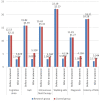Effects of balance training in addition to auxiliary activity on balance function of patients with stroke at high risk for falls
- PMID: 36686536
- PMCID: PMC9849380
- DOI: 10.3389/fneur.2022.937305
Effects of balance training in addition to auxiliary activity on balance function of patients with stroke at high risk for falls
Abstract
Objective: The aim of this study was to investigate the effect of balance training in addition to auxiliary activity on the balance function of patients with stroke at high risk for falls.
Methods: A total of 112 patients with stroke at high risk for falls in our hospital from inception to January 2020 to December 2020 were selected as the research objects who were equally divided into the control group and study group according to the random number table method. Patients in the control group were intervened with auxiliary activity, and the patients in the study group received additional balance training for auxiliary activity. The balance function, lower extremity motor function, fall risk, walking ability, and other indicators were compared between the two groups of patients before and after treatment. The hospitalization time and the frequency of falls 3 months after discharge were also compared between the two groups.
Results: Before treatment, there was no significant difference in balance function, lower extremity motor function, fall risk, and walking ability scores between the two groups (P > 0.05). After 3 months of treatment, the balance function, lower extremity motor function, and walking ability scores of the study group were significantly higher than those of the control group, with the fall risk score significantly lower than that of the control group (P < 0.05). Evidently, lower hospitalization time and the frequency of falls in the 3-month follow-up of the study group were observed than those in the control group (P < 0.05). However, there was no significant difference in the frequency of falls between the two groups during hospitalization (P > 0.05).
Conclusion: Our results indeed revealed that balance training in addition to auxiliary activity elicited beneficial outcomes in terms of effectively improving the balance function and walking ability of patients with stroke at high risk of falling, which may have the potential for wide clinical application.
Keywords: activity auxiliary; balance function; balance training; stroke; stroke fall.
Copyright © 2023 Tan, Gong, Xing, Cao, Liu and Xu.
Conflict of interest statement
The authors declare that the research was conducted in the absence of any commercial or financial relationships that could be construed as a potential conflict of interest.
Figures





Similar articles
-
Dual-Task Exercise Reduces Cognitive-Motor Interference in Walking and Falls After Stroke.Stroke. 2018 Dec;49(12):2990-2998. doi: 10.1161/STROKEAHA.118.022157. Stroke. 2018. PMID: 30571419 Clinical Trial.
-
Perturbation-based gait training to improve daily life gait stability in older adults at risk of falling: protocol for the REACT randomized controlled trial.BMC Geriatr. 2020 May 7;20(1):167. doi: 10.1186/s12877-020-01566-z. BMC Geriatr. 2020. PMID: 32380950 Free PMC article. Clinical Trial.
-
Effect of Early and Intensive Rehabilitation after Ischemic Stroke on Functional Recovery of the Lower Limbs: A Pilot, Randomized Trial.J Stroke Cerebrovasc Dis. 2020 May;29(5):104649. doi: 10.1016/j.jstrokecerebrovasdis.2020.104649. Epub 2020 Feb 27. J Stroke Cerebrovasc Dis. 2020. PMID: 32115341 Clinical Trial.
-
Does whole-body vibration training have a positive effect on balance and walking function in patients with stroke? A meta-analysis.Front Hum Neurosci. 2023 Jan 4;16:1076665. doi: 10.3389/fnhum.2022.1076665. eCollection 2022. Front Hum Neurosci. 2023. PMID: 36684839 Free PMC article.
-
Obstacle avoidance training for individuals with stroke: a systematic review and meta-analysis.BMJ Open. 2019 Dec 16;9(12):e028873. doi: 10.1136/bmjopen-2018-028873. BMJ Open. 2019. PMID: 31848159 Free PMC article.
Cited by
-
The effects of different types of RAGT on balance function in stroke patients with low levels of independent walking in a convalescent rehabilitation hospital.Open Med (Wars). 2025 Jun 27;20(1):20251212. doi: 10.1515/med-2025-1212. eCollection 2025. Open Med (Wars). 2025. PMID: 40585913 Free PMC article.
-
Evaluating muscle characteristics and fall events: insights from real-world longitudinal data.Ann Med. 2025 Dec;57(1):2526709. doi: 10.1080/07853890.2025.2526709. Epub 2025 Jul 3. Ann Med. 2025. PMID: 40605464 Free PMC article.
-
Development and validation of a dynamic nomogram for high care dependency during the hospital-family transition periods in older stroke patients.BMC Geriatr. 2024 Oct 12;24(1):827. doi: 10.1186/s12877-024-05426-y. BMC Geriatr. 2024. PMID: 39395968 Free PMC article.
-
Differences in symptom clusters based on multidimensional symptom experience and symptom burden in stroke patients.Sci Rep. 2025 Apr 5;15(1):11733. doi: 10.1038/s41598-025-96189-y. Sci Rep. 2025. PMID: 40188267 Free PMC article.
References
-
- Pan JL, Zhao Q, Hu L. Investigation of middle-aged and elderly patients with acute hemorrhagic stroke complicated with cognitive impairment and analysis of related factors. Prac Prevent Med. (2022) 29:245–8.
LinkOut - more resources
Full Text Sources

